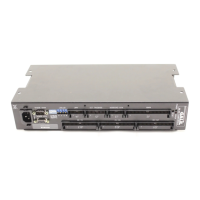34 • Chapter 4 Communication DMC-1500
3 Receive Data - input 8 Receive+ input
4 RTS - input 9 RTS+ input
5 Ground
*RS422 - Auxiliary Port {P2}
1 CTS - input 6 CTS+ input
2 Receive Data - input 7 Receive+ input
3 Transmit Data - output 8 Transmit+ output
4 RTS - output 9 RTS+ output
5 Ground
*Default configuration is RS232. RS422 configuration available by factory.
Configuration
Configure your PC for 8-bit data, one start-bit, one stop-bit, full duplex and no parity. The baud rate
for the RS232 communication can be selected by setting the proper switch configuration on the front
panel according to the table below.
Baud Rate Selection
Switch Setting Interpretation
1200 9600 19.2K
ON ON OFF 300 Baud rate
ON OFF OFF 1200 Baud rate
ON OFF ON 4800 Baud rate
OFF ON OFF 9600 Baud rate
OFF OFF ON 19200 Baud rate
OFF ON ON 38400 Baud
ON ON ON SELF TEST
The RS232 main port can be configured for handshake or non-handshake mode. Set the HSHK switch
to ON to select the handshake mode. In this mode, the RTS and CTS lines are used. The CTS line
will go high whenever the DMC-1500 is not ready to receive additional characters. The RTS line will
inhibit the DMC-1500 from sending additional characters. Note, the RTS line goes high for inhibit.
The handshake should be turned on to ensure proper communication especially at higher baud rates.
The auxiliary port of the DMC-1500 can be configured either as a general port or for the daisy-chain.
When configured as a general port, the port can be commanded to send ASCII messages to another
DMC-1500 controller or to a display terminal or panel.
(Configure Communication ) at port 2. The command is in the format of:
CC m,n,r,p
where m sets the baud rate, n sets for either handshake or non-handshake mode, r sets for general port
or the auxiliary port, and p turns echo on or off.
m - Baud Rate - 300,1200,4800,9600,19200,38400
n - Handshake - 0=No; 1=Yes
r - Mode - 0=General Port; 1=Daisy-chain

